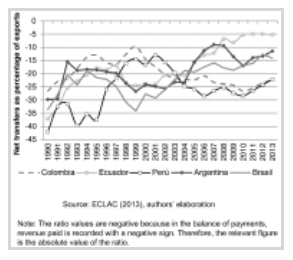
By P. Samaniego, M.C. Vallejo, J. Martinez-Alier
Abstract
This article analyses the Physical Trade Balances (PTB) of five South American economies since 1990. Both exports and imports (measured in tonnes) increased but exports were consistently much larger than imports. Such large Physical Trade Deficits (PTD) persisted throughout the 1990s and 2000s. Export prices of primary goods increased but by 2013, export prices had declined and the exports could no longer pay for imports. Countries started to show commercial trade deficits (in money terms). These findings hold for all the South American countries analysed and they show that the optimism generated by the improving terms of trade in South America at the beginning of the 21st century was premature. First, there were PTDs even in the boom years; second, the deterioration in the terms of trade after 2012 was accompanied by a counterproductive deficit in the monetary trade balance. It is counterproductive because, in principle, it leads to greater external debts or to outflows of currency reserves. It can also create pressure to increase physical exports. We argue that deficits in the monetary trade balances tend to be compensated by increasing the deficit in the PTB, which can lead to enhanced environmental pressures and therefore to local protests.
Keywords
Trade deficit
Terms of trade
Ecologically unequal trade
Environmental burdens
Link
http://www.sciencedirect.com/science/article/pii/S0921800915301579
email hidden; JavaScript is required
Acknowledgements
This article is a contribution to the project: “ERC Advanced Grant 2016–21, Global Movement for Environmental Justice”.

The project ENVJUSTICE has received funding from the European Research Council (ERC) under the European Union’s Horizon 2020 research and innovation programme (grant agreement No. 695446)